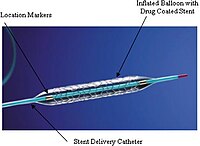
Photo from wikipedia
INTRODUCTION AND OBJECTIVES There are limited data on the usefulness of intravascular ultrasound (IVUS) for long coronary lesions treated with second-generation drug-eluting stents. We evaluated IVUS predictors of major adverse… Click to show full abstract
INTRODUCTION AND OBJECTIVES There are limited data on the usefulness of intravascular ultrasound (IVUS) for long coronary lesions treated with second-generation drug-eluting stents. We evaluated IVUS predictors of major adverse cardiovascular events (MACE) 12 months after implantation of everolimus-eluting stents for long coronary lesions. METHODS A total of 804 patients who underwent both postintervention IVUS examination and long everolimus-eluting stent (≥ 28mm in length) implantation were included from 2 randomized trials. MACE was defined as a composite of cardiac death, myocardial infarction, and target-lesion revascularization. RESULTS MACE occurred in 24 patients (3.0%) over 12 months. On multivariable Cox regression analysis, independent IVUS predictors of MACE included the postintervention minimum lumen area (MLA) at the target lesion (HR = 0.623; 95%CI, 0.433-0.895; P=.010) and the ratio of MLA/distal reference segment lumen area (HR = 0.744; 95%CI, 0.572-0.969; P=.028). The MLA and MLA-to-distal reference segment lumen area ratio that best predicted patients with MACE from those without these events were 5.0 mm2 and 1.0, respectively. Patients with MLA<5.0 mm2 or a distal reference segment lumen area had a higher risk of MACE (HR = 6.231; 95%CI, 1.859-20.891; P=.003) than those without MACE. CONCLUSIONS Patients with a postintervention IVUS-measured MLA of<5.0 mm2 or a distal reference segment lumen area were at risk for MACE after long everolimus-eluting stent implantation.
Journal Title: Revista espanola de cardiologia
Year Published: 2017
Link to full text (if available)
Share on Social Media: Sign Up to like & get
recommendations!